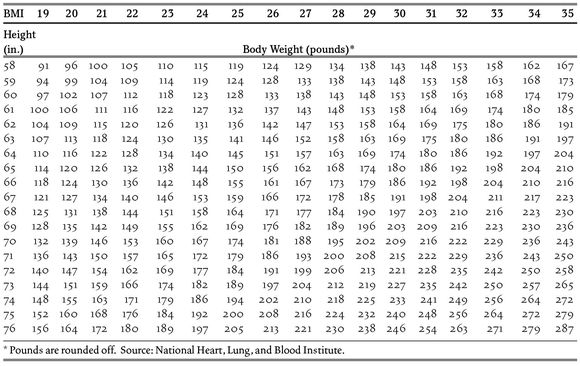The adage “you are what you eat” neatly summarizes many truths about human health and well-being. Food is the raw material from which the body obtains the substances it needs to grow, reproduce, repair itself, and fight disease. A diet composed of good food choices gives the body the chemical compounds it needs. A diet deficient in essential molecules inhibits or skews basic physiological mechanisms, preventing the body from functioning properly.
Nutrients
Essential nutrients are substances needed by the body to grow and remain healthy. Macronutrients are needed in large amounts; they include proteins, carbohydrates and fats. Micronutrients are needed in very small quantities; they include vitamins and minerals. Two other critical components of a healthy diet are fiber and water.
Proteins The body needs twenty essential amino acids to assemble approximately 10,000 different kinds of proteins. These proteins include enzymes, antibodies, hemoglobin, components of cell membranes and bone, and so on.
Meat, poultry, seafood, legumes, dairy products, nuts, and seeds are rich sources of proteins. Most Americans eat far more protein than necessary, though protein-deficiency diseases are common in some poor countries. Excess dietary protein is broken down and either used as an energy source or converted into fat.
Carbohydrates Carbohydrates—sugar and starches—are the body’s primary source of energy. During a complex series of chemical reactions within cells, carbohydrate molecules are broken down to release the energy needed for everything from maintaining body temperature and heartbeat to moving limbs and eyelids. Most excess dietary carbohydrates are converted into fat.
Fats The category of nutrients known as lipids include solid fats, liquid fats (oils), and cholesterol. These substances provide insulation, protect internal organs, maintain healthy skin, and play important roles in vision, hormone production, and the formation of cell membranes. However, excess dietary fat increases the risk of heart disease, diabetes, cancer, and other health problems.
There are two types of dietary fats: saturated and unsaturated. Saturated fats are the so-called “bad” fats. They are found in red meat, lard, dairy products, coconut and palm oil, and egg yolks. Within the body, they raise total blood cholesterol and low-density lipoproteins (LDL), the main source of cholesterol buildup and blockage of arteries. Unsaturated fats, the so-called “good” fats, include polyunsaturated fats and monounsaturated fats. Most come from plant sources. They lower LDL and raise high-density lipoproteins (HDL), which help prevent cholesterol from building up in arteries.
Trans fatty acids (trans fat) are components of unsaturated fats that have been hydrogenated to make them solid at room temperature. They are found in margarines, peanut butter, and commercially baked goods and fried foods. They raise total cholesterol and LDL and may lower HDL.
Cholesterol and Triglyceride Levels
| Blood Level (mg/dL)* | Significance | |
|---|---|---|
| Total Cholesterol | ||
| Less than 200 | Desirable | |
| 200-239 | Borderline high | |
| 240 or higher | High | |
| LDL | ||
| Less than 100 | Optimal | |
| 100-129 | Near optimal | |
| 130-159 | Borderline high | |
| 160-189 | High | |
| 190 or higher | Very high | |
| HDL | ||
| Less than 40 | Low | |
| 40-59 | Acceptable | |
| 60 or higher | Optimal | |
| Triglycerides | ||
| Less than 150 | Acceptable | |
| 150-199 | Borderline high | |
| 200 or higher | High | |
| * Milligrams per deciliter of blood. | ||
| Source: Lung, and Blood Institute | ||
Cholesterol is an essential component of cell membranes and needed for the production of sex hormones and other important compounds. However, high levels of blood cholesterol increase people’s risk for heart disease. Generally, foods high in saturated fats are also high in cholesterol.
Another form of lipids in the blood is triglycerides—fat molecules consisting of three fatty acids joined to a glycerol molecule. They are important in helping to transfer energy from food into body cells, but excessive levels increase heart disease risk.
Vitamins and Minerals These micronutrients are involved in numerous body processes, from building blood cells to transmitting chemical signals and regulating body temperature. A deficiency can result in illness. For example, insufficient intake of the B-vitamin niacin can lead to pellagra, a disease marked by diarrhea, dermatitis, dementia, and if untreated, death; a deficiency of dietary calcium can result in osteoporosis, a disease characterized by brittle, easily broken bones. Excessive doses of vitamins and minerals can also be dangerous. Too much vitamin A can cause nerve damage, hair loss, blurred vision, and birth defects; excessive zinc can cause a copper deficiency by competing with copper at absorption sites in the intestine.
Since the 1940’s, the National Academy of Sciences has provided Recommended Daily Allowances (RDAs) for vitamins and minerals. An RDA indicates the amount of a vitamin or mineral that meets the nutrient needs of about 98 percent of all the healthy individuals in a specified gender and age group.
Vitamin and mineral needs change markedly during life. Gender, tobacco use, and whether a woman is pregnant or lactating also affect needs. For instance, a typical teenage female needs about 1200 mg of calcium daily; after age 25, about 800 mg of calcium are considered sufficient. A 7-year-old child needs 13 mg of niacin daily; a 15-year-old boy should have 20 mg daily and a 60-year-old man about 15 mg daily.
Fiber Dietary fiber is a complex mixture of plant materials that are resistant to digestion by the human digestive system. There are two major types: insoluble (cellulose, hemicellulose, lignin) and soluble (gums, mucilages, pectins). Insoluble fiber is found mainly in vegetables, wheat bran, and whole grains. Foods high in soluble fibers include oats, dry beans and peas, and fruits such as apples, oranges, and strawberries.
Fiber provides bulk for the formation of feces, thus hastening the passage of feces through the lower digestive system and helping to prevent constipation and the formation of diverticula (small pouches in the walls of the large intestine). It provides a feeling of fullness, helping to satisfy appetite. Studies also indicate that adequate dietary fiber helps reduce the risk of heart disease and diabetes and may help prevent colon cancer.
Water The human body is one-half to four-fifths water, with water composing about 70 percent of lean muscle, more than 75 percent of the brain, and about 80 percent of the blood. Water carries nutrients and oxygen to cells, cushions joints, helps regulate body temperature, removes wastes, and helps prevent constipation. Some research indicates sufficient water intake reduces the risks of colon cancer, bladder cancer, fatal heart attacks, and kidney stone formation. Insufficient water intake can result in dehydration.
On average, an adult loses about 10 cups of fluid a day—in urine, feces, perspiration, and exhaled breath. Most of this fluid needs to be replaced by drinking water or other non-alcoholic beverages; the rest is obtained from solid foods. Fluid intake should be increased when engaged in intense physical activities or working in warm environments.
Diet and Dieting
Daily nutritional needs vary from one person to the next, and change as a person moves through life’s stages. Genetics, chronic diseases, activity levels, and pregnancy can impact nutritional needs; allergies, availability of food, and cultural and religious beliefs can influence which foods are chosen to meet these needs. Nonetheless, certain basic principles should be followed to assure good health, maintain an ideal weight, and reduce the risk of heart disease, cancer, diabetes, and other diseases:
–Eat a variety of foods.
–Do not overeat; keep portions small or moderate-sized.
–Eat plenty of fruits, vegetables, and whole grains.
–Limit intake of sugar, salt, saturated fat, and cholesterol.
–Drink plenty of water.
–Exercise daily.
The Value of Vitamins
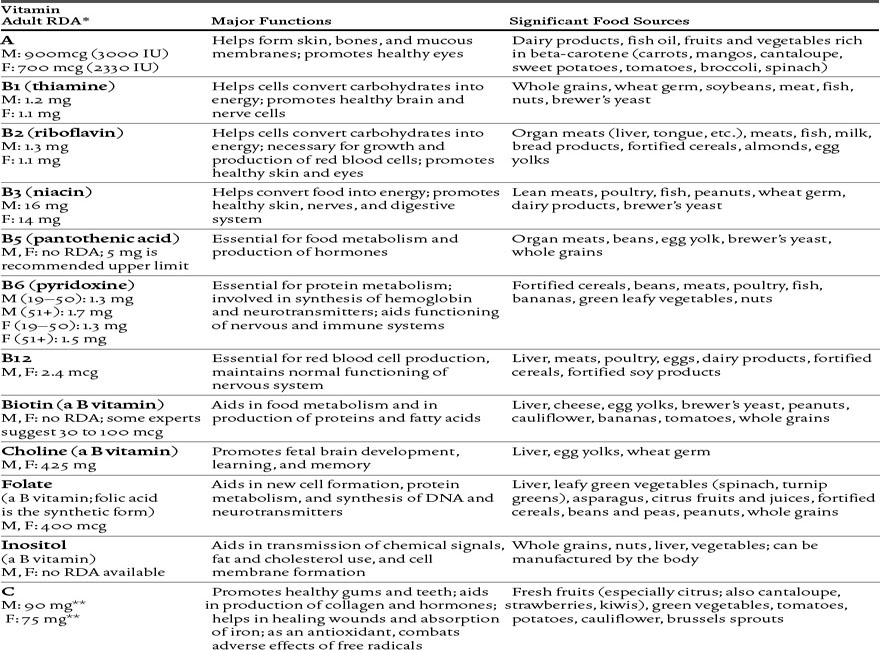
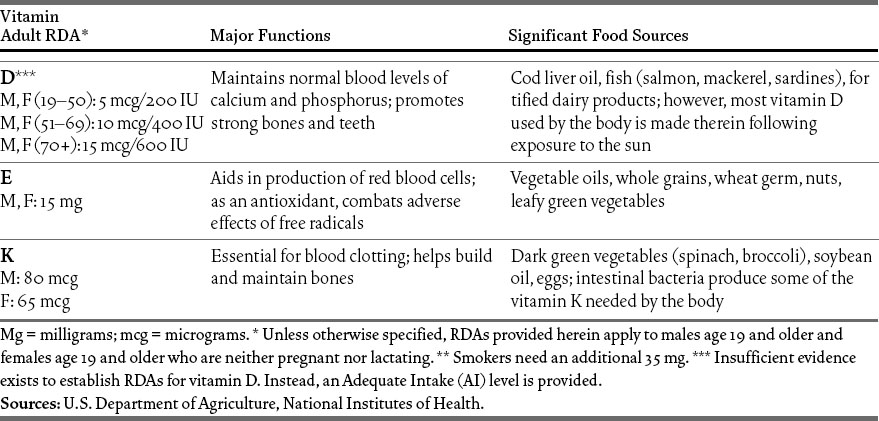
The Value of Minerals
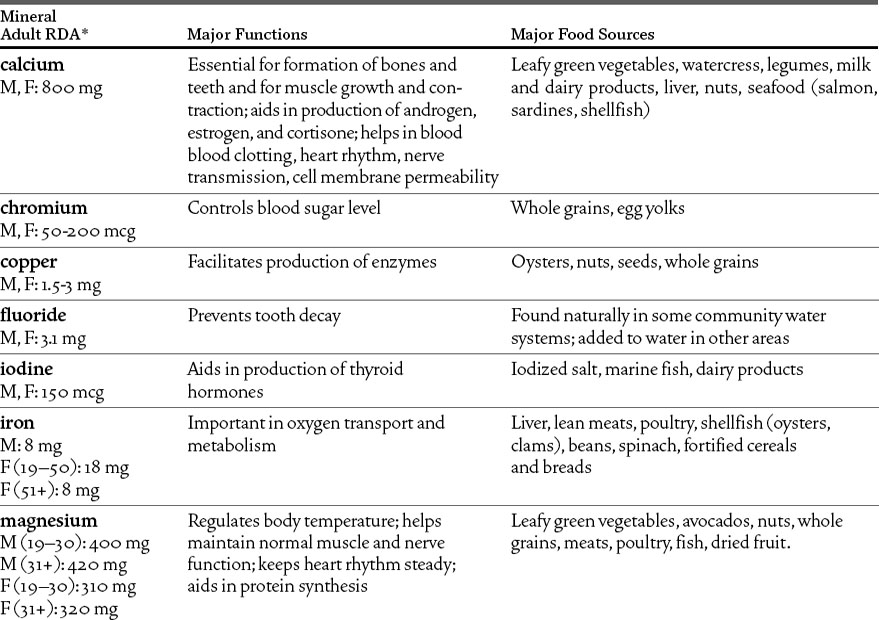
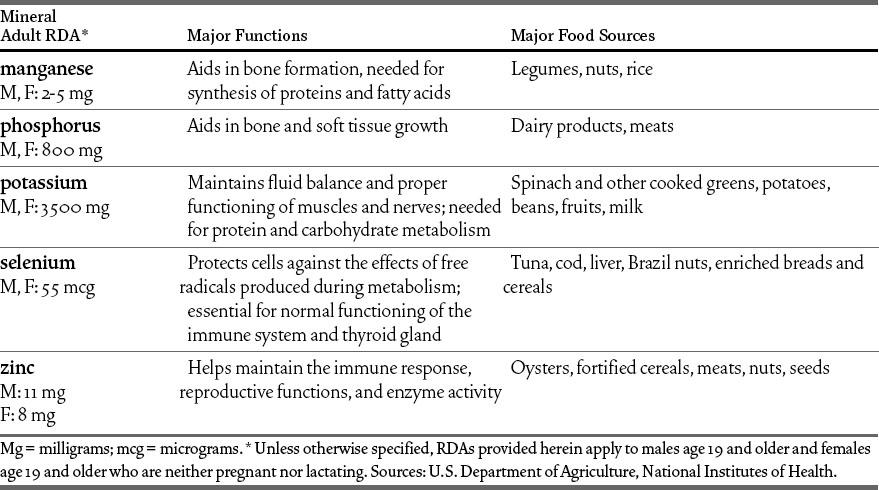
How Long Does It Take to Burn Off Calories?
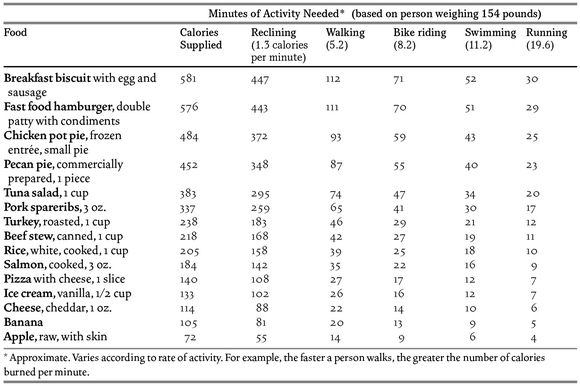
Food Guidelines For years, healthy eating plans were most often illustrated in the shape of pyramids that outline what to eat each day. Food meant to be consumed in large quantities comprised the base of the pyramid, while sugars and fats were the tip. The most familiar example was the Food Guide Pyramid, established by the U.S. Department of Agriculture and Department. Even the most recent of these, called MyPyramid, introduced in 2005, was criticized as being too complicated at a time when more than one-third of American adults are obese.
In 2011, the Department of Agriculture, First Lady Michelle Obama, and the Surgeon General introduced MyPlate, a new food guide diagram that looks like a divided dinner plate. It illustrates, for example, that half of a meal should consist of vegetables and fruits, and that low-fat dairy should be consumed only on the side. MyPlate not only recommends portions, but also specifics such that whole grains should be eaten over refined grains. The accompanying website is meant to help Americans learn how to stretch their dollar while purchasing fresh produce over packaged commodities.
Calories Calories measure the potential energy in the food we eat. Foods vary widely in caloric content, particularly when factors such as processing and condiments are taken into consideration. For instance, one cup of raw strawberries contains 53 calories; one cup of frozen, sweetened, sliced strawberries has 245 calories. Similarly, 1 cup of air-popped popcorn has 31 calories; a similar amount of caramel-coated popcorn has 152 calories.
The number of calories a person burns up during a typical day depends on age, sex, size, and activity level. Teenage boys, many active men, and some very active women consume about 2,800 calories a day. Most children, teenage girls, active women, and many sedentary men burn about 2,200 calories a day. Many sedentary women and some older adults burn about 1,600 calories a day.
If a person takes in more calories than are burned up, the excess is stored as fat. In general, an excess deposit of 3,500 calories equals one pound of fat. To get rid of this pound of fat, the person must burn up the 3,500 calories.
Weight-Loss Diets To lose weight, a person must eat fewer calories than he or she burns. How one attempts to do this varies tremendously. Some people use the slow and steady approach of dietary and lifestyle modifications—basically, eating less and exercising more. Others try fasting and other rapid-fire approaches, or one of the many weight-loss diets described in books or offered commercially. Some of the most popular weight-loss diets include:
The Atkins diet A high-fat, low-carbohydrate diet with few limits of the amount of food that can be eaten. In the first two weeks, carbohydrates are severely restricted. Without carbohydrates, the body burns stored body fat and goes into a state called ketosis, which tends to decrease appetite. After two weeks, fiber-rich carbohydrates are gradually added to the diet—but no refined sugar, milk, white rice, white potatoes, or products made with white flour.
Weight Watchers A diet in which each food is assigned a point value based on its caloric, fat, and dietary fiber content. For example: one cup of broccoli has 0 points, one slice of bread 2 points, one ounce of chocolate 4 points, and a 6-ounce steak 8 points. No foods are prohibited but the person is expected to eat only a certain number of points each day, based on body weight, with extra points earned by exercising. Weekly meetings in which dieters receive support from one another are an important part of the program.
The Ornish Diet A high-fiber, low-fat vegetarian diet that consists mainly of grains, beans, vegetables, and fruits. Nonfat or very low-fat dairy products may be eaten in moderation; eating meat, oils, nuts and seeds, sugar, and most dairy products is discouraged. The quantity of calories is not considered critical but less than 10 percent should come from fats.
What Counts as a Serving?
| Grains Group | |
| 1 slice of bread | |
| 1 cup of ready-to-eat cereal | |
| 1/2 cup of cooked cereal, rice or pasta | |
| Vegetable Group | |
| 1 cup of raw leafy vegetables | |
| 1/2 cup of other vegetables cooked or raw | |
| 3/4 cup of vegetable juice | |
| Fruit Group | |
| 1 medium apple, banana, orange, pear | |
| 1/2 cup of chopped, cooked, or canned fruit | |
| 3/4 cup of fruit juice | |
| Milk Group | |
| 1 cup of milk or yogurt | |
| 1 1/2 ounces of natural cheese, such as Cheddar | |
| 2 ounces of processed cheeses, such as American | |
| Meat and Beans Group | |
| 2 to 3 ounces of cooked lean meat, poultry or fish | |
| 1/2 cup of cooked dry beans or 1/2 cup of tofu counts as 1 ounce of lean meat | |
| 2 1/2-ounce soyburger or 1 egg counts as 1 ounce of lean meat | |
| 2 tablespoons of peanut butter or 1/3 cup of nuts counts as 1 ounce of meat | |
| Source: U.S. Department of Agriculture. | |
The Zone diet Somewhat higher in fats and proteins than traditional diets. An individual on the Zone obtains 40 percent of daily calories from carbohydrates such as beans and vegetables, 30 percent from low-fat proteins, and 30 percent from unsaturated fats. Saturated fats and carbohydrates that release glucose quickly (grains, bread, pasta, rice, etc.) are restricted.
South Beach diet A three-phase diet in which Phase 1 is to eliminate cravings for sugars and starches; Phase 2 is to induce long-term weight-loss; and Phase 3 is meant to maintain the healthy weight achieved. The diet plan doesn’t cut food groups out—devotees know it as the “food lover’s diet”—but instead focuses on eating the “right” carbs and fats. The emphasis is on vegetables and fruits that are fiber-rich and nutrient-dense. Arthur Agatston, the cardiologist credited with developing the plan, recommends at least 20 minutes of exercise daily to achieve desired results.
Diet Pills Weight-loss drugs, whether prescribed or bought over-the-counter, were developed to help persons with obesity or obesity-related conditions such as high blood pressure or obesity. Though some drug companies claim that their pills will enable a person to shed pounds without much work, in order for diet pills to be truly effective, they must be taken in combination with physical activity and healthy eating. There are two main types of weight-loss pills: appetite suppressants and fat absorption inhibitors. Appetite suppressants can be bought at most drug stores, and work by increasing serotonin or catecholamine to fool the body into believing it is full. Fat absorption inhibitors prevent the body from breaking down fat. Xenical is the only fat absorption inhibitor approved for use in the U.S., sold over the counter as Alli.
There are no studies that conclusively report that any of these diet pills are effective over the long term, and taking them comes with several risks. People can develop tolerances, become addicted, or may experience side effects ranging from an increased heart rate or blood pressure to constipation, anxiety, headaches, insomnia, and excessive thirst.
Weight Guidelines One of the most accurate ways to determine the correlation between weight and health risks is body mass index (BMI). A BMI of less than 18.5 is generally considered a signal that an adult is underweight. A healthy BMI for most adults is between 18.5 and 24.9. A BMI of 25 to 29.9 is considered overweight; one of 30 or more is considered obese. The higher the BMI, the greater the risk of cardiovascular disease, diabetes, cancer, premature death, and other health problems.
Body Mass Index
